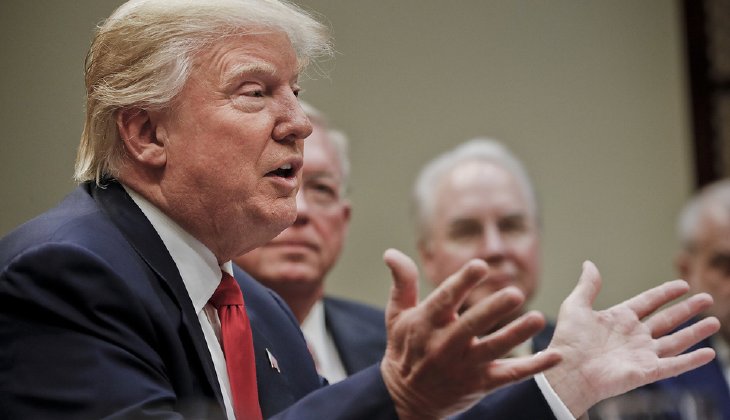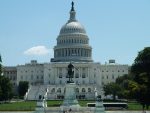To characterize Trumps first couple months as tumultuous would be an understatement for the ages. The president’s relentless attacks on the media and his provable lies to the press have begun to erode the credibility of his administration. He hasn’t slowed down since his campaign in attacking anyone who critiques or challenges his beliefs (particularly in the media). The most frightening fact of it all is that he’s now the leader of the free world; not to mention the fact that the FBI is investigating a sitting president only three months into his term.
In terms of policy, Trump’s first defining legislation came with the healthcare bill meant to replace Obamacare. Repealing and replacing the Affordable Care Act has been at the very top of the GOP agenda for the last seven years. Now, with a Republican Senate, House and president, they had the best chance to do just that. Unfortunately for the president, the bill was a humiliating defeat.

While the health care bill sputtered in Congress, the American people got some important insight into Trump’s policies. Not only did the bill exemplify a complete dismantling of his predecessor’s administration, but also showed crippling cuts across the board which would have resulted in 24 million Americans losing their health insurance.
In line with most of Trump’s presidency so far, his proposed 2018 budget leaves reason for plenty of people to be worried.
Trump’s campaign laid out a grand plan for rebuilding America in his image. Unfortunately, the massive restructuring (particularly with the wall), will not be cheap and will have dire costs to many. His preliminary budget began to highlight some of those who will be effected by the restructure.
The Losers
1. Environmentalists
Arguably hit the hardest under these proposed budget cuts are environmentalists (or, I guess I can rephrase that to mean anyone who would like to breathe clean air for the foreseeable future). After some promising years under the Obama administration, with increases in alternative energy and the groundbreaking Paris climate agreement, progress looks like it may be stopped in its tracks.
The current president is on record saying that climate change is a hoax fabricated by the Chinese in order to develop a trade advantage. Meanwhile, the new head of the Environmental Protection Agency (EPA), Scott Pruitt, campaigned against Obama’s Clean Power Plan. Suffice it to say, climate change wasn’t at the top of the Trump agenda; rather, climate change progress is threatened to be sent back several decades.
Under the proposed budget, the EPA gets completely gutted. It proposes a $2.6 billion cut (-31 percent) and would clean house with the elimination of over 3,200 positions (20 percent of the total department.) Most importantly, it calls for the elimination of the Clean Power Plan, an act issued through the Obama administration in an effort to cut down on carbon emissions from power plants. Trump also plans to discontinue any funding for future climate change research and eliminating any U.S. funding towards U.N. climate change initiatives.
Ocean research also received a major hit. The budget would eliminate the National Oceanic and Atmospheric grant and programs for coastal and marine management from the department of commerce’s budget. More specifically, $250 million would be cut from coastal research programs designed to prepare communities affected by rising seas and worsening storms. I guess the Trump administration won’t be worried about rising seas with the “alarmist global warning hoax.”
To make matters worse, growing alternative sectors get the ax big time. Not only does the budget plan on cutting or completely eliminating clean energy technology, but it gives major advantages to the fossil fuel and nuclear industries. With increased drilling for oil and gas on public lands and an increase in nuclear waste, the promising alternative energy field loses precious ground
2. United Nations
Trump campaigned on the slogans “America First” and “Make America Great Again,” so it should be no surprise that the budget reflects a giant step back in international diplomacy. Behind the EPA, the State Department received the most widespread cuts, with a $10.9 billion cut (-29 percent).
Losing out the most by far with these cutbacks was the United Nations (U.N.). As per Trump’s campaign promise, the budget reflected giant slashes with the U.N. funding. The budget reduces funding for U.N. peacekeeping and completely eliminates any funding towards U.N. climate change initiatives.
The State Department budget refocuses the funding towards the Fulbright program, an international educational exchange program, and Israeli military aid. The budget also reflects major cuts to the World Bank ($650 million over three years) and cultural exchange programs like the East-West Center in Honolulu, a center established by the U.S. Congress in 1960 designed to improve cooperation and communication with Asian and Pacific nations.
3. Science & the Arts
Despite grand claims Trump made in his speech to Congress of “cures to illnesses,” and “American footprints on distant worlds,” Trump’s plan decimates scientific research across the board. A proposed $5.8 billion cut (-18 percent) to the National Institutes of Health (NIH), would bring the NIH to its lowest budget in the last 15 years and would eliminate the program put in place to train scientists in developing countries.
Possibly more worrying, the cuts could leave no room for new research grants in 2018. According to former NIH deputy director Kathy Hudson, “The nation would lose research and researchers in a way that would not be recoverable. It’s pretty terrifying.”
How the president thinks he can “cure illness” without any new research grants is beyond me. The massive cuts in NIH resemble one of many significant cuts to research in multiple agencies.
The Department of Interior’s U.S. Geographical Survey (USGS) would be cut approximately 15 percent. NASA would receive a 1 percent cut overall, and 5 percent to its earth science programs, not exactly the way to get a man on Mars.
Also evident in the preliminary budget is the lack of attention to detail. The National Science Foundation (NSF), a major backer of about $7.5 billion toward academic research in multiple fields, is not mentioned once in the budget.
The state of limbo in which NSF finds itself puts the future of academic research in a precarious position.
The arts and humanities also got the short end of the stick with the proposed budget allocation. The National Endowment for the Humanities (NEH) is one of the organizations the administration plans to completely eliminate from the budget. The NEH is incredibly vital to providing funding for “research, education and outreach in the humanities and social sciences.”
The demise of the 52-year-old organization could put the future research of the humanities and social sciences in an equally dismal state. The outlook for the arts is even bleaker, with a complete elimination of funding for the National Endowment for the Arts (NEA), Institute of Museum and Library Services, and the Corporation for Public Broadcasting.
4. Working-Class Americans
Trump’s great rallying cry in his campaign was the fight for the common man. He was going to “drain the swamp,” and essentially “Make America Great Again” by making Americans rich again. So far, he’s appointed the wealthiest cabinet in U.S. history, and predictably is providing kickbacks and advantages to the richest 1 percent, while the working class is taking the brunt of the bullet.
The lack of perspective into the working class starts with the Department of Education, and specifically, Secretary of Education Betsy Devos. The budget eliminates the funding for before-school, after-school and summer-school programs. Devos instead is focusing on a $1.4 billion investment in charter schools, private schools and “other school-choice initiatives.”
The Department of Education also received major cuts for aid programs for first-generation and low-income college students. The department is clearly taking the direction of its head billionaire, Devos, while leaving many public-school students behind.
The Department of Housing and Urban Development has more cuts that hurt the working class. The budget would stop funding the Community Development Block Grant Program, a program designed to develop anti-poverty programs, and would cut funding for some initiatives including affordable housing and rental assistance.
The Department of Labor budget indicates a cutback in job training programs targeting senior citizens, disadvantaged youth and the unemployed.
Trump certainly rode the momentum of the working class in America’s heartland. Now, across the board, the working and middle class are thrown under the bus.
The Winners
Predictably so, the widespread cuts help fund an increased defense budget, a stronger presence at the southern border and a strengthening of the fossil fuel industry.
1. Fossil Fuel Industry
Trump’s election was one of the worst scenarios for the alternative energy sector to get out of the shadow of the fossil fuel industry. The decimation of the EPA and institutional denial of climate change are major victories for the fossil fuel industry, especially with the elimination of the Clean Power Act. For years, the industry had to tiptoe around rigid legislation and regulations, as much of the world began to tackle the question of what will happen when the resources run out.
Now the party largely unconvinced on the reality of climate change has control of Congress and the presidency. While the cuts in the EPA certainly give the industry a foot forward, the budget allocation in the Departments of Energy and Interior are the real game changers.
The Department of Energy would see $1.7 billion cut across the board (-6 percent). The cuts almost exclusively focus on eliminating clean energy technology, including a $900 million cut from the Office of Science. The administration would essentially take out the legs from the fossil fuel industries’ competition, and any chance of finding a lasting renewable energy source may be delayed another several decades.
The final blow would come from the Department of Interior budget with increased funding for programs drilling for oil and gas on public lands. With this move, the administration could move the U.S. miles behind the clean energy initiatives made by much of the industrialized world.
2. Veterans’ Health Care
One bullet-proof section in the budget is the allocation to the Department of Veterans Affairs (V.A.). The V.A. has been a train-wreck under the Obama administration and could be one of Trump’s greatest successes, only if he plays his cards right. Under the first budget proposal, the V.A. is one of the largest earners, with a $4.4 billion increase (+6%), with most of the funding going to veterans’ health care programs.
The greatest flaw of the V.A. under the Obama administration was veterans waiting for months, even years, to get treatment, costing many of them their lives. The budget aims to tackle the problem head on. The budget would allow for the addition of more than 45,000 vacant medical positions. It would also help expand Veterans Choice, a program designed to give veteran patients options to see private doctors outside of the V.A. The administration certainly has to do much more than simply throwing money at the V.A. to make any impact, but with these proposals, they may be on the right track.
3. Defense
After listening to Trump’s rhetoric, it shouldn’t be a shock to hear the biggest winners in the budget proposal is America’s security forces (Departments of Homeland Security and Defense.) Homeland Securities massive $2.8 billion hike (+7%) is mainly dedicated to Trump’s most noteworthy and divisive piece of policy: the wall.
Around $2.6 billion of the funds are allocated to border security infrastructure, technology, and beginning to develop the southern wall. The funds allow an increase of about 500 Border Patrol agents and 1,000 Immigration and Customs Enforcement officers. The rest of the increased funds will primarily be funneled to detaining and removing illegal immigrants. Going after undocumented citizens and locking up the southern border certainly doesn’t seem like empty rhetoric anymore, and it won’t be cheap.
The biggest recipeint in the proposed budget is the Department of Defense, with an increase in $52.3 billion (+10 percent). The increase of funding would cause a proposed increase size of the Army and Marines, increase the Navy fleet and buy new F-35 fighter jets. It certainly feels like the administration is building up for a military intervention, most likely in the fight against ISIS.
The proposed budget leaves more points of worry than not. Decimations in environmental regulation could bring back clean air issues Americans haven’t seen in over 40 years, while multiplying the number of carbon emissions in a world which has already passed the point of no return with carbon in our atmosphere.
The scientific and medical community could be handcuffed in achieving no significant breakthroughs for the foreseeable future. The fossil fuel industry could regain its monopoly on American power. The increased armament in border security and armed forces could send divisive shockwaves both here at home and overseas.
The important thing to remember is that Congress still holds the purse strings. They may choose to not follow the direction of President Trump, and instead, develop a very different budget for 2018. Only time will tell.

















